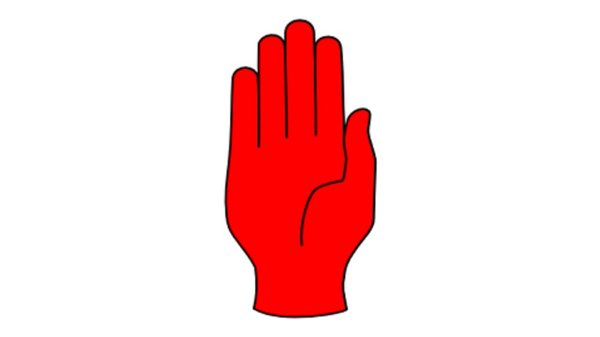
Frank Quinn’s Tyrone jacket with the Red Hand logo
I began the New Year sporting the Red Hand of Tyrone on a borrowed jacket, the property of Frank Quinn in Glenmalure. So I was fascinated to read the following history of the symbol of Ulster in An Irishman’s Diary written by Frank McNally, part of which is reproduced here:
“The question of which foot you use while digging has in Ireland long had a significance that goes beyond matters of horticulture. But during a visit to Belfast recently, I was struck by the contrasting neutrality, in political symbolism, of the hand.”

Red Hand in the Ulster Rugby logo
“I’m thinking mainly of the Red Hand, that ubiquitous symbol of Ulster. Unlike most emblems, it straddles the political and sectarian divide. And on both sides, it’s usually the right hand (dexter) that’s depicted, although there are quite a few left hands scattered around Belfast on coats of arms and other insignia, with apparently equal indifference.
This is all the more surprising given that there are two competing explanations for the symbol’s origins. One is religious, referring to the hand of God (His right, invariably), a meaning mentioned in Milton’s Paradise Lost and a Nick Cave song, Red Right Hand, among other places.
The alternative is the prehistorical myth of the Iberian invaders, promised Ulster as the prize in a boat race. The first to touch it would win, so within sight of the finish, the most committed of the trio chopped his hand off and threw it ashore, a result that withstood the subsequent stewards’ inquiry.
By the law of averages (and most versions of the story), however, it was the invader’s right hand that did the chopping, and therefore his left that claimed the reward. Maybe that explains some of the left-hand versions in Belfast. But then again, as far as I can see, loyalist murals, just like GAA insignia, tend to go with with the right.
Not that the Red Hand is entirely the property of Ulster. It used to symbolise Ireland in general. And again, this could be ambidextrous. You see lefty versions on, for example, old cap badges of the Irish Citizen Army. But I suppose there is a certain logic in that.
The foot question has its contradictions too. In the South, it is Protestants who are (or were) said to the dig with the left. In the North, the same claim was made of Catholics. The point in both cases was that they were the minority. Whichever foot they dug with it, it was the “wrong” one.

Red Hand in Mid Ulster Council logo
One the other other hand (no pun intended), that great student of Ireland’s idiosyncrasies, (QUB Professor) E. Estyn Evans, once went into the subject in meticulous detail and found a depth of meaning in it that few who used the phrase could have suspected.
In his 1957 book, Irish Folk Ways, he wrote that most diggers in Ireland used the right foot – a habit reinforced by the traditional one-sided Irish spade, or “loy”, which unlike the English version, didn’t offer a choice.
But he added that, “in eastern Ireland, and particularly the Protestant districts of the north-east, the left foot is normally the digging-foot […] though the old Irish stocks continue to dig with the right”. In general, he marvelled at the “astonishing variety” of spades here, as witnessed by a Tyrone factory that specialised in the product. Its “spade gauge book”, he reported, had 230 different patterns.
The Tyrone factory had recently closed, he noted. And I suspect that the complexity of Irish spade technology had peaked by then. Even so, anyone who still thinks that “calling a spade a spade” is synonymous with verbal simplicity should read Irish Folk Ways. For me, at least, it sheds new light on Seamus Heaney’s famous decision, circa 1966, to dig with a pen.”

Red Hand (dexter version)
The left hand version (sinister) of the symbol has been used by the Irish National Foresters, the Irish Citizen Army and the Federated Workers Union of Ireland, subsequently SIPTU.
